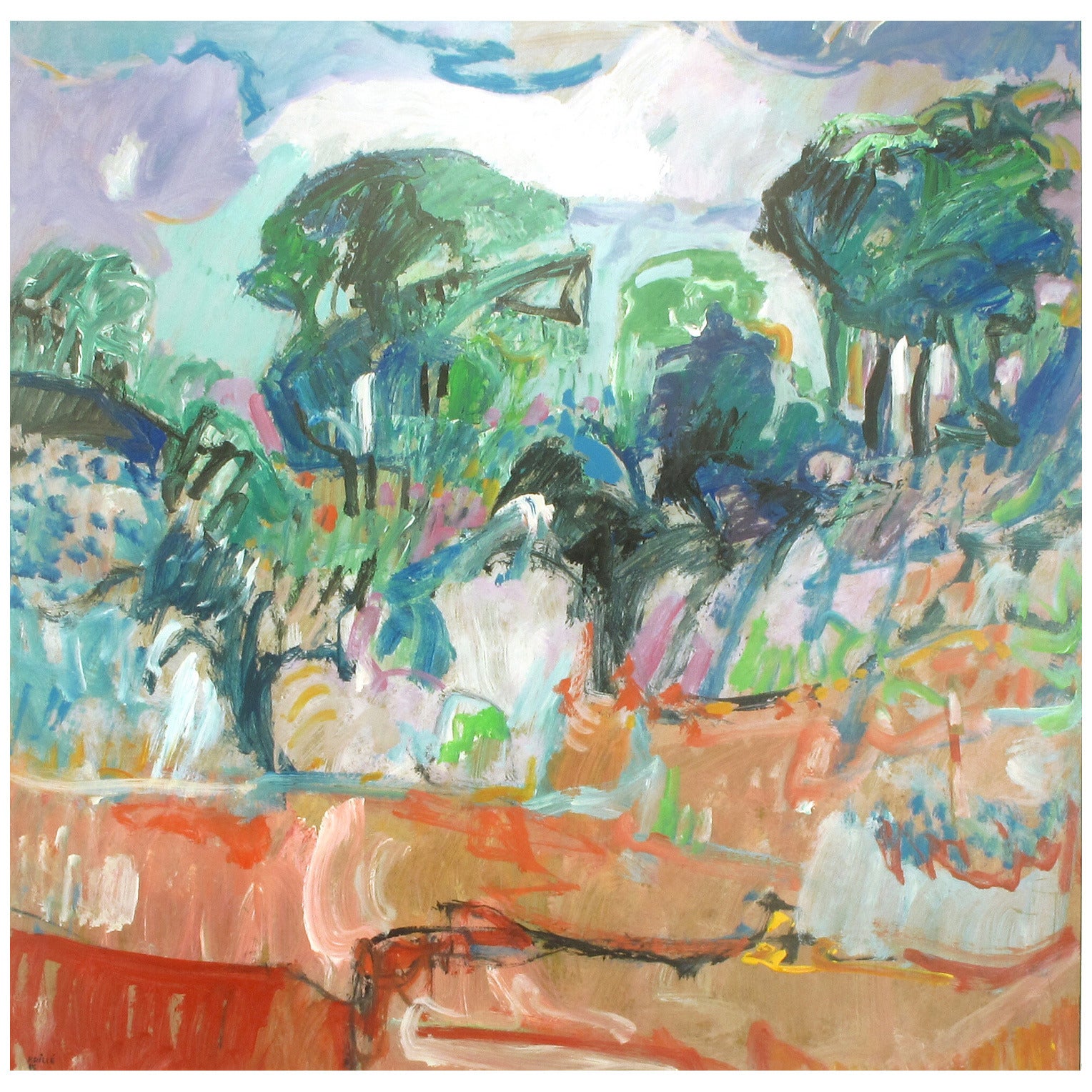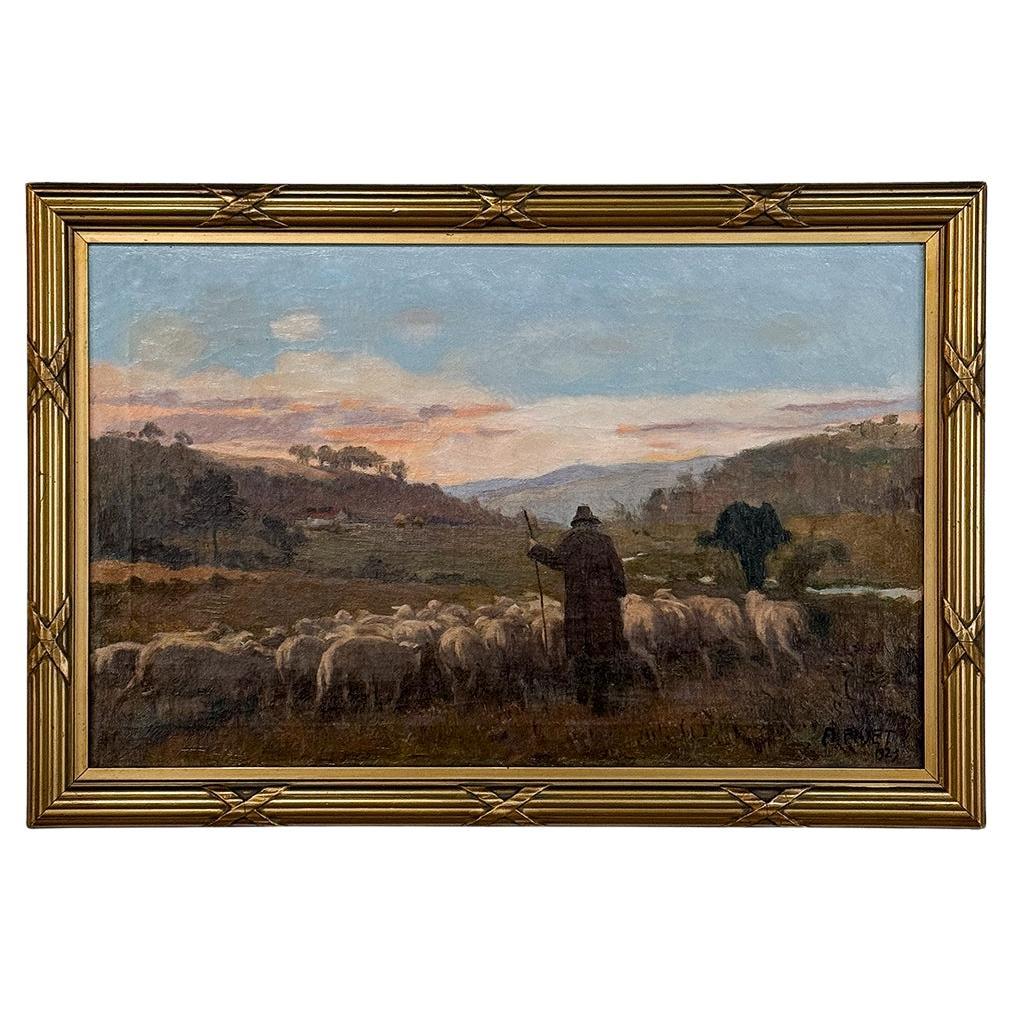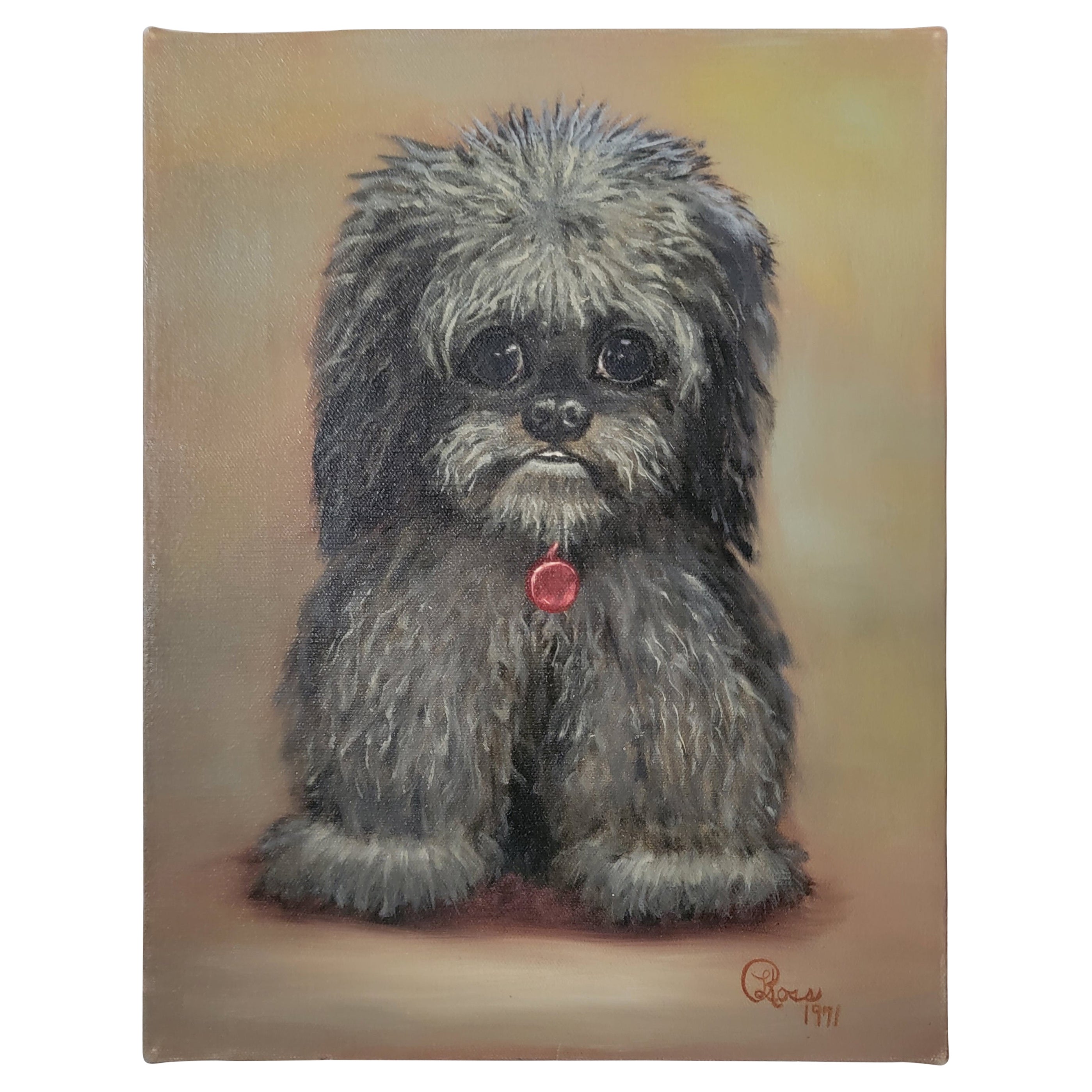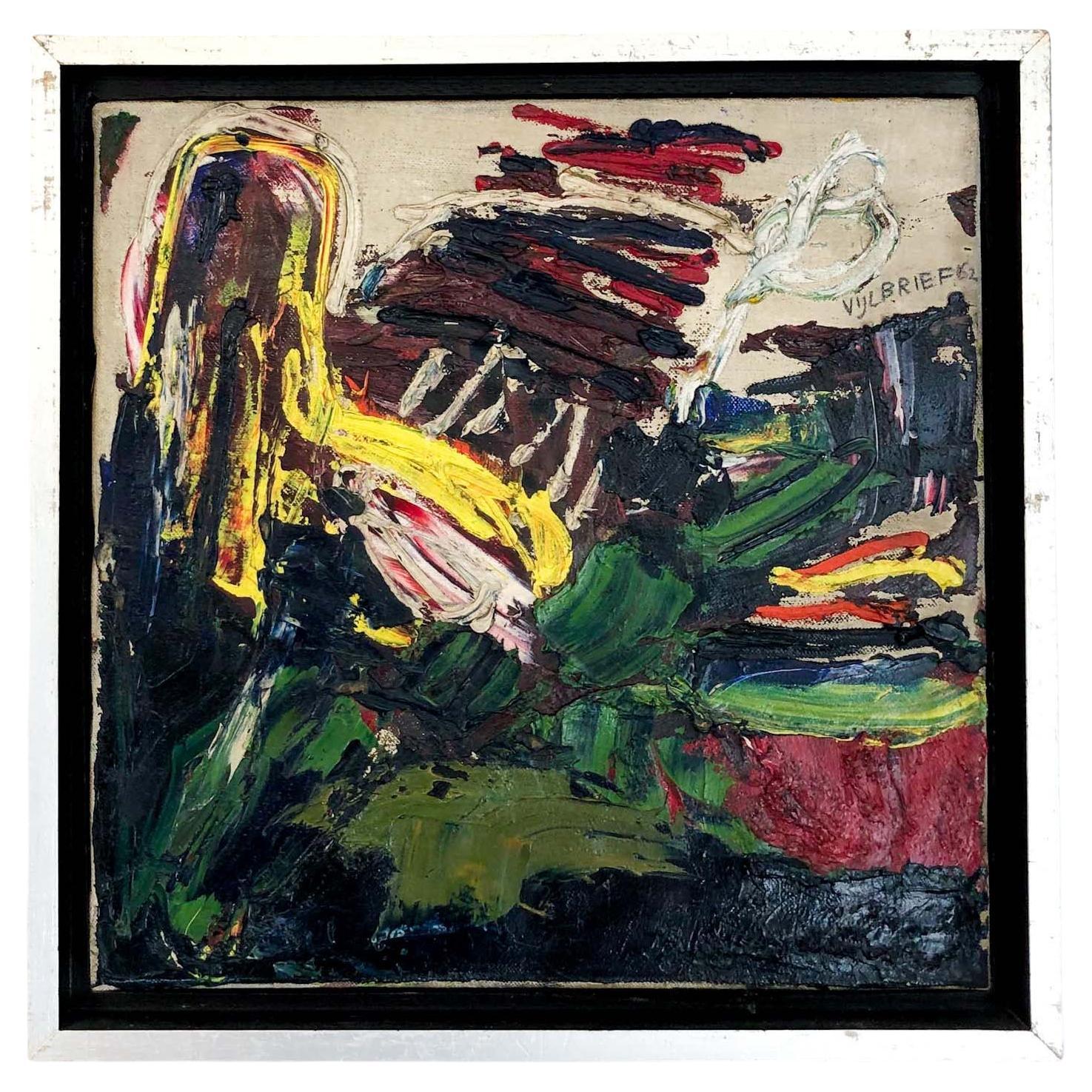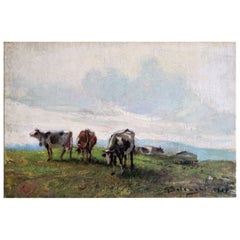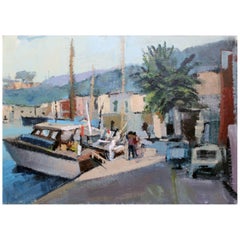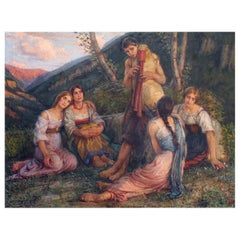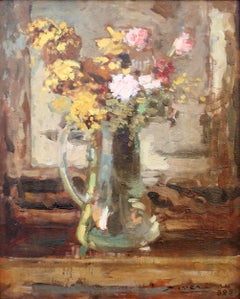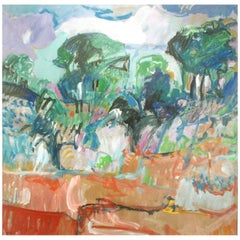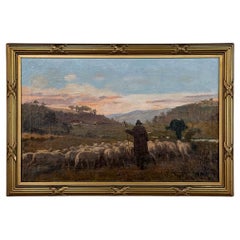Corrado Mezzana (Italian 1890-1952) well known painter
Oil in canvas, museum quality piece
Title: "Georgica" (official archive)
Artwork dimensions: 132 x 102cm
Period: 1931
Signed: C. Mezzana (Lower left corner)
Decipting a late 1800s country scene (Sardegna) with 5 figures in the period fashion induments. The boy is playing his "Zampogna" (Tipical Sardinia ancient instrument as a Highlands pipe - Uilleann Bag pipe) meantime the four "georgica's" carefully are lessoning him
Conditions: Absolutely beatiful with extensive conservative work done including; deep cleaning (old varnish/dirt removed), wax method partial (border) relining, minor retouching and a fresh coat of Damar
Offered unframed
I will consider fair offers from serious buyers only.
Note: Available circa 45 high-resolution images regarding this gorgeous piece. Feel free to message me if you wanna see even more details and other frames of it.
Provenance - Mezzana archive
Last ownership (Monti Family - Milano) bought in 1953
Original title and production year (1931) received directly from his grandson which after attested his originality, send me a picture of a antique previous "study" regarding a left couple of "Georgiche" (or Contadine Aka: countrygirls) before this original painting were produced - SEE LAST PICTURE
^^^^^^^^^^^^^^^^^^^^^^^^^^^^^^^^^^^^^^^^^^^^^^^^^^^^^^^^^^^^^^^^^^^^^^^^^^^^^^^^^^^^^^^^^^^^^^
Research and Sources
The Sacred Heart of CM, in Christian Art , XI (1923), 6, pp. 161 s .;
CM, in Revue moderne , 15 apr. 1925, pp. 13 s .;
Il Glauco by C. M. , In Corriere d'Italia , 28 May 1927;
The new chapel of the relics in S. Croce, in L'Osservatore Romano, 18th apr. 1930;
M. Mirabella, The Virgil stamps , in Fiamma viva , XI (1931), pp. 229-235;
P. Scarpa, The monumental crypt to the military chaplains in the church of S. Caterina in Magnanapoli , in Il Messaggero , 1st November. 1933;
N. Pende, Art and Typological Science in the Sacred Heart of CM , in Roman Rassegna , IX (1937), pp. 31-35; MG Franci,
The Vatican issues of the war years , in the philatelic yearbook , Rome 1945, pp. 29-34;
E. Diena, Parla CM, the artist of our stamps , in Italy philatelic , IV (1946), 22-23, pp. 245-251;
Est-ce vraiment possible ?, in L'Observateur de Genève , XX (1951), 1, p. 6;
Artisan candidates in Rome. C. M. , In Italian Craftsmanship , V (1952), 9, p. 4;
E. Amadei, Memory of CM The man and the artist , in Il Quotidiano , 24 w. 1952;
L. Palermo, Philately. Memory of CM , in Il Giornale , Oct. 17. 1952; R. Michetti, E. Martire and C. M., Rome 1953, pp. 11-15;
CM Exhibition postuma (catal.), Rome 1953 (with extensive bibliography);
R. Michetti, C. M. , In Faith and Art , 1953, n. 4, pp. 107-114;
Vice, C. M. , In Il Giornale d'Italia , 12 April 1953; F. Zeri, Italian stamps ... ,
History of Italian art , IX, 1, Torino 1980, pp. 315-318;
O. Orsini, The stamp in history and art , Rome 1981, pp. 117, 142, 144, 147, 150;
F. Filanci - L. Mezzana Zilli, The art of the stamp: CM , Bologna 1990;
H. Waga, Known and Unknown Life of the Virtues at the Pantheon, Rome 1992, pp. 51, 80;
P. Mezzana, The Popes in the stamps of C. M. , In Il Dialogo , II (2005), 4, p. 18.
^^^^^^^^^^^^^^^^^^^^^^^^^^^^^^^^^^^^^^^^^^^^^^^^^^^^^^^^^^^^^^^^^^^^^^^^^^^^^^^^^^^^^^^^^^^^^^
Buy with confidence. Your experience is really important to me.
Please note: To maintain the integrity of these valuable pieces this lot will be shipped fully insured, professionally boxed, and offered with a traceable shipping freight worldwide WHICH is already included in the freight cost presented for your location. 100% satisfaction guaranteed or your money back
Have a look for more original art pieces in my shop.
Photographs in this listing are image quotations from the work that is offered for sale. © Copyright holder.
^^^^^^^^^^^^^^^^^^^^^^^^^^^^^^^^^^^^^^^^^^^^^^^^^^^^^^^^^^^^^^^^^^^^^^^^^^^^^^^^^^^^^^^^^^^^^^
BIO
He was born in Rome on 7 June 1890 by Giuseppe, an official of the Post Office, and Rosa Morelli.
In 1906, at the same time as his high school studies, he attended the studio of the landscape painter P.
Joris. The training then continued at the free school of the nude at the Institute of Fine Arts (1908-10) and
at the University of Rome, where he graduated in jurisprudence in 1912 with the thesis Legislation of Fine
Arts and Antiquities published the following year in Rome.
Starting from 1906, the first charcoal portraits are also documented ( CM , 1953, p.11) and from 1911 the
works with a social subject such as Port unloaders ( ibid. , Table 1).
In 1914 Mezzana got in touch with G. Giovannoni and F. Hermanin, through which he developed a keen
interest in architecture. In the same year he participated with naked Man in the painting competition of the
Regia Accademia di S. Luca (Rome, Accademia di S. Luca, inv. 957) and obtained the qualification to teach
drawing in technical schools and artistic institutes. Moreover, he exhibited the oil painting Rinascita at the
exhibition of the Society of amateurs and lovers of fine arts in Rome, which saw him annually present until
1928 with the Consecration of Chinese bishops (1927, reprinted in CM ... , 1983, pl. 9).
In the same period, in tune with the widespread taste in the capital of those years, Mezzana matured a predilection for the
crepuscular atmospheres ( Dante al Monastero del Corvo , 1914, Rome, Mezzana collection), represented with a connatural sentimental vein and a spelling dry and sharp.
In 1915 he was invited to the San Francisco International Exposition, where he presented the Antoninian
Baths and began to teach drawing in the Michelangelo Buonarroti circle and in the ornamental arts school of
the Municipality of Rome.
During the war period Mezzana suspended the activity of scholar and artist to devote himself to the
organization of the military hospital De Merode of Rome (1916-17) and was then an artillery officer
(1917-18).
In 1919 he married Albertina Giorelli, with whom he had six children, and began working as a production
designer in the production company Tespi film in Rome (1919-22).
In 1922 he created the first framework of social engagement, Glauco (1922; Rome, Mezzana collection), with
a clear symbolist imprint, in the wake of the masonry works of A. De Carolis and A. Calcagnodoro.
The evocative and didactic approach is characteristic of the works of Mezzana, especially in this period
( Elegi abiectus esse in Domo Dei , 1926, CM ... , 1953, plate 7), with the exception of landscapes, where he
expressed his best artistic qualities, painting with scrupulous respect for the truth ( Dogliani , 1928, ibid .,
plate 11).
In the same years, he carried on the work of a publicist and from the pages of the Catholic magazine Gioventù
nuova (1914-24) he came to the heart of the issues of historical-artistic philology. He also continued his
exhibition activity by participating in the second and third Rome Biennial in 1923 and 1925. In the latter he
exhibited a collection of decorations and the sketch for the altarpiece, Christ between s. Catherine of Siena and
s. Margherita Alaquoque (1922), realized for the chapel of the Sacred Heart in the Basilica of S. Maria sopra
Minerva. At the same climate and in the same period belong the tempera dedicated to the life of s. Giovanni
Bosco (1929, Turin, Institute of the Salesians) and the cartoons for the stained glass and mosaics of the
chapel of the relics in S. Croce in Gerusalemme in Rome ( CM ... , 1953, plate 13), pervaded by a
pictorialism and expressive sentimentality pathetic tones.
From the beginning of the Thirties, the main focus of interest was the commitment to artistic issues as a
scholar and conservative. Designed, assisted by A. Muñoz, the crypt under the church of S. Caterina
Magnanapoli (1933) and obtained the setting up of the hall of industry and craftsmanship at the Augustan
Show of Rome (Rome, 1937).
Especially after 1930 Mezzana devoted himself to the study of a series of
great figures: Leonardo da Vinci, GL Bernini,
Giotto di Bondone...
